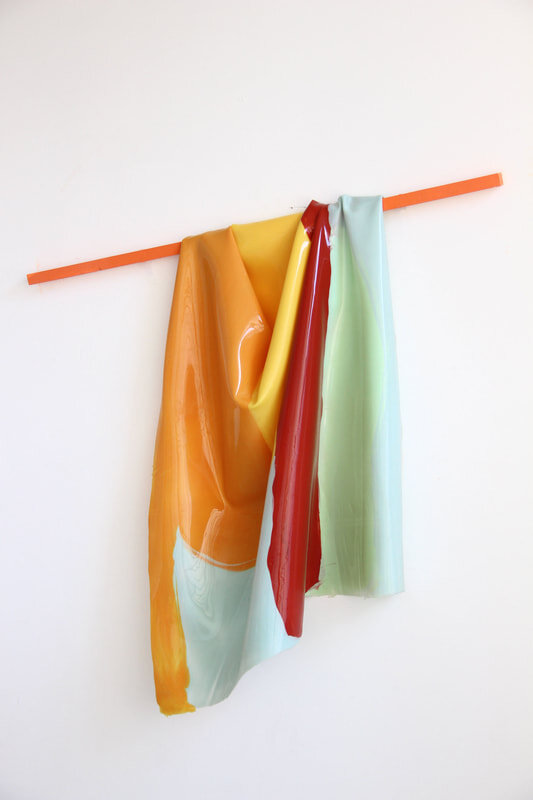Manon Steyaert: Mediating Materials
Text by Luz Hitters
March 2021
Manon Steyaert (Brussels, 1996) is fresh, creative and curious. She defines herself as impatient, even if I don't believe that is the word that represents her best. I would much rather use the term resourceful or ludic. In my opinion, she is one of few that surfs this overly-stimulating world deftly and capitalises on every impute.
Her practice stems from the challenge of painting as a medium and the exploration of colour. Behind each of her pieces, there is unconventional research and a genuine inquisition into the possibilities each opportunity offers. Steyaert has developed her palette through trial and error: in her Instagram projects requesting sunsets during the lockdown, layering industrial textures, and using watercolours. The end result is the mastering of a balance between complexity and harmony.
MS: "When I started with the latex in terms of colour separation, I held on to words that I thought were important. Interruption was very important to me in terms of colour: interrupting your gaze. I wanted to separate layers of colour physically in my painting because I just felt it wasn't layering them on the canvas-it wasn't fulfilling my curiosity with colour."
Silicone Pastel Dreams, Manon Steyaert.
Delicious, Manon Steyaert.
Currently, Steyaert uses silicone as her main medium. Her work splits between 'installations' and 'paintings', yet they all converge in sculpture, as she states she disliked the flatness of a canvas. For her paintings, she hangs, stretches and wraps different shades of silicone around the frame, achieving an overlay of mellifluous folds. By blurring the line between sculpture and painting, the artist overcomes the limits of attention spans and achieves a meditative reflection on tones and textures.
MS: "I've always been more interested in the physicality of the materials and seeing them behave with painting, rather than the action of painting itself. Also in the fluidity and the continuity of the gaze, on being entranced by the material.
Everything I know about sculpture, I was using painting materials to make my sculptures. I wasn't using true painting materials, I was using sculpture materials, so I inverse the two. I like I make painterly sculptures and sculptural paintings. I don't really see them as the individual medium; I see them in limbo with one another."
A key aspect of her work is that she makes her own materials from scratch. This also proves the artist's endless curiosity and exhaustive search for a balanced palette. By colouring silicone sheets such as in her Interrupted Gaze (2020) series or Gazing In (2020), she merges together aspects of fashion and industrial production. Her materials' industrial nature also suggests intermediation between different worlds, repurposing connotations and challenging fixed perspectives.
Gazing In, Manon Steyaert.
"I was interested in support systems within a painting and how I can take off the material of the frame and see whether it can live on its own. So I've always been juggling between taking the painting off the wall and then bringing it back. So by making my own material, I thought that it creates its own support system."
The concept of support systems is also explored in her work Can You See Me (2020). Inspired by the industrial and derelict buildings surrounding her in Portugal, Steyaert examines the underlying materials used to create concrete. In the same manner she folds her silicone, the artist folds wire meshing and spray-paints it. The end result is organic shapes that disappear into space. As such, Steyaert challenges the viewer's perceptions, creating figures that fade in and out of focus and only become visible due to the cumulation of material.
Can You See Me, Manon Steyaert.
Materials and mediums have connotations of their own. Beyond the possibilities and limitations each provides, they act as a metaphor for each artist's creative message. However, in Manon Steyeart's art, the choice of materials challenges the clichés of these associations.
"When it comes to working with materiality, and the idea of materials, many of them have already connotations attached to them. People associate latex with fetish, or very bodily references; Louise Bourgeois, Eva Hesse.
This wasn't my focus. I focused on painting and sculpture and the perceptions with those mediums rather than analysing the medium itself. I like to refer my paintings to traditionality and non-traditional materials. You could relate those two together in terms of the paint and the silicon."
Interrupted Gaze, Manon Steyaert.
Nonetheless I believe there is a sensuality in the wetness of the materials and the folded drapes, this is also matched by a romantic undertone, which seems almost incompatible with the charged and oppositionist sexuality these materials have been historically associated with. This concept acts as a metaphor for other aspects of Steyaert's work: a meeting point between two seemingly antagonistic discourses. As such, she is a mediator between distinct generations and perspectives.
Last, the concept of time seems to be a key aspect unifying her search. With inspiration ranging from old masters to concrete, and the implementation of new mediums, Steyaert's artistic practice seeks for a meeting point—a timeless conclusion. As such, she reconciles viewpoints and proves that every discourse has been contemporary at some point.











